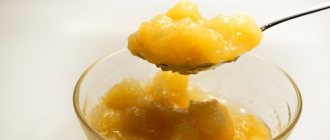6
Prepared by: Yana Gornostaeva
02/01/2017 Cooking time: 1 hour 0 min
| Save | I cooked) | Estimate |
Potato and carrot puree can be used as a light and healthy side dish for meat or fish dishes. Moreover, this is an excellent food option for babies who have not yet learned to chew.
Carrot treat
At what age can a baby be fed carrots? How to prepare complementary foods from a vegetable mixture and how much to give?
Carrot puree can be introduced into complementary foods at five months, when the baby’s digestive system is ready to receive first courses of vegetable and fruit mixtures.
However, carrot puree for babies carries the danger of an allergic reaction to the active substances of this vegetable. Pediatricians recommend introducing complementary foods made from green vegetables, which do not have pronounced allergenic properties.
The introduction of carrots, tomatoes and other brightly colored fruit crops should begin with a minimal portion (the tip of a teaspoon).
After treating yourself to carrots, you need to carefully monitor the baby’s condition to see if he feels unwell.
If the body reacts positively to the introduction of a new dish, the portion should be increased by a spoon per day. How much puree can you give at one time? No more than 100 grams. To keep your baby full, you can add another vegetable mixture to the carrot mixture: zucchini, broccoli or potatoes.
Carrots and babies
Many parents wonder when to introduce carrot complementary foods into their child’s diet and how much. In what form should we offer complementary foods, and is there a risk of encountering problems such as allergies? Scientists from the Institute of Nutrition and most pediatricians recommend starting to introduce your baby to carrot juice. If the child is breastfed, it is better to postpone complementary feeding until 7–9 months. For artificial babies, these periods can be shorter, 5–6 months.
Making your own puree
Where to get carrots for complementary feeding, how to cook them correctly? Boil carrots until soft in a small amount of water. It is better to cook in a double boiler - this way all the valuable substances will be preserved in the fruit and will not partially pass into the liquid.
Some mothers are concerned about the effect of nitrates on the health of their infants. To get rid of doubts and worries, remove the core from the fruit: this is where unnecessary substances accumulate.
Should I cut the carrots into wedges or cook them whole?
There are different technologies for cooking vegetables:
- Boil the grated vegetable in a small volume of liquid;
- Steam carrots cut into slices or in water;
- Cook the whole fruit by steaming or in water.
When the carrots become soft, remove them from the water and pass them through a sieve or blender.
Important! The fruits, pureed through a sieve or blender, must be boiled for a minute and only then offered to the baby.
What are the benefits of carrots?
- Carotene is an element that helps synthesize vitamin A in the body. It is also called growth vitamin. Therefore, carrots help babies grow strong and healthy.
- Vitamins B, C, E, K and mineral salts.
- Fiber and dietary fiber contribute to the proper functioning of the digestive system, which helps relieve constipation.
- Helps develop visual acuity.
- Protects the body from overwork.
- Supports normal functioning of the heart and circulatory system.
- Chewing on raw carrots can strengthen your gums.
- Our ancestors used this vegetable as an anti-inflammatory and analgesic, as well as to treat the common cold.
- Supports normal kidney and liver function. Many gardeners grow carrots in their plots; this vegetable is available to everyone at any time of the year.
Carrot puree
Carrot puree for babies can be prepared in different ways. The simplest recipe: beat the boiled fruit in a blender and add a drop of olive oil to the finished mass. If your baby loves butter, you can add 5 grams of ghee. For the very first complementary foods, it is recommended to add breast milk or formula to the puree.
Sugar and salt are prohibited from being added to dishes for infants under one year of age. Vegetables contain the required amount of natural salt.
Useful properties and tips
This root vegetable is useful because it contains many useful elements. Among them is carotene, which supports vision and is a good preventative against Alzheimer's disease and cancer. Since it is absorbed only with fats, it is recommended to add vegetable or butter and dairy products to dishes.
READ ALSO: Top 10 incredibly sweet and productive gooseberry varieties
There are some tips that will help you decide on a carrot puree recipe and make cooking easier. It's better to remember them:
- It is recommended to serve this dish with sour cream, because it emphasizes the taste well, and carotene is absorbed even better.
- The usefulness of the root vegetable does not change depending on whether it was steamed or cooked in the usual way.
- If the puree is served for dessert, you can add pear, plum or apricot to it. Carrots go best with these fruits.
- To dilute the puree with your own carrot juice, you need to prepare it as follows: peel it, put it in a saucepan coated with oil, and add water. Simmer for about 30 minutes, periodically turning over and adding water.
- To improve the taste of the side dish, you can add a little cumin to it. The main thing is not to pour too much, otherwise the taste will be worse.
https://youtube.com/watch?v=Sle07nvdBuE
Carrots with potatoes
This recipe can be used when the baby is familiar with these vegetables and willingly eats them separately for lunch.
- Remove the skins from the vegetables.
- Cut into small cubes.
- Place in boiling water and cover the saucepan with a lid.
- Cook without salt until soft.
- Drain the liquid and beat the puree with a blender.
- Boil the finished mixture for a minute on fire.
- Add half a spoon of vegetable oil (it is better to take olive oil).
Important! The water for cooking vegetables must be brought to a boil and then reduced to a low simmer. The fruits are boiled with the lid closed.
Rules for introducing complementary foods
We bring to your attention a few simple tips, following which you can introduce complementary foods without all possible negative consequences.
- Carrots, like any new product, must be introduced into the diet gradually; the product can provoke allergic reactions, it is important not to cause harm.
- When first introducing the product to your baby, offer half a teaspoon of juice or puree diluted with water. It is better to do this in the morning meal, so that you can monitor the child’s body’s reaction to complementary foods.
- If your first acquaintance with carrots was successful, you can gradually increase the portion. It is not recommended to drink juice daily; there is a high risk of increasing the level of bilirubin in the blood, if this occurs, the skin and mucous membranes of the child’s eyes take on a yellowish tint.
Carrots with cauliflower
Carrot puree goes well with a variety of fruits and vegetables. Often the puree is mixed with boiled vegetables, and carrot juice is added to apple juice. A recipe with cauliflower is one of the options for preparing carrots with other vegetables.
For one carrot we take:
- cabbage inflorescences: 130-140 grams;
- water: 1.5-2 cups;
- vegetable oil: teaspoon.
First, put the carrots prepared for cooking into boiling water, and after 9-10 minutes add the inflorescences. Cook the vegetables over low heat for another 7-9 minutes and drain the water.
Now you need to make a mixture from the pieces using a strainer or blender. The finished mass should be boiled and oil should be added. You can dilute the puree with formula or breast milk.
Carrots for a runny nose are the best cure
The benefit of this wonderful vegetable is that its juice can be used to treat a runny nose due to its antimicrobial properties. There are no contraindications for the use of this method; even for newborn children, such a medicine cannot cause harm. In addition to treating a runny nose, the juice can be used for sinusitis, rhinitis and other diseases accompanied by sinus congestion. For children, when treating a runny nose, concentrated juice is diluted in a ratio of 1 part juice to 2 parts water. If you need to cure an older child for a runny nose, dilute the concentrate 50 to 50.
We open up the question: Selecting and preparing buckwheat porridge for the first feeding
Puree for the winter
If you grow carrots in your garden, you can stock up on baby food for the winter. This recipe is very simple, but requires careful preparation and sterility.
Carefully peel approximately 1.5-2 kilograms of carrots and cut them into small slices, cook for about 30-34 minutes. While the fruits are boiling, sterilize the jars and lids.
We puree the carrots, put them in jars and pasteurize them in a water bath. After the lid, we roll up the jars and send them to the basement or a cool, dark place for storage.
How long to store? Until the next carrot harvest.
Cooking options
Juice
For kids, they prepare it exclusively fresh. The washed and peeled vegetable is soaked for several hours in boiled water, after which it is grated and manually squeezed using a bandage or several layers of gauze. Dilute by 50% with water. Do not offer your child juice more than 1-2 times a week to avoid oversaturating the fragile child’s body with vitamins and causing harm. You can mix the juice with apple juice.
Puree
It has a pleasant sweet taste and kids really like it. Puree, like juice, contains a huge amount of useful minerals and vitamins. If you are going to cook the puree yourself, make sure that the carrots are environmentally friendly. We cut the washed and peeled vegetable in half and remove the core, since it may contain nitrates that can cause harm. Fill the carrots with water for several hours and finely chop them, after which you need to cook them over low heat until they become soft. Grind the boiled vegetable, bring the puree to a boil again, and let it cool. You can add a little breast milk, formula or a few drops of vegetable oil. This will help make the puree more liquid; the benefit is that, due to the added fats, the child’s body will absorb vitamins in the most effective way.
We give complementary foods in the same way as juice, starting with half a teaspoon. To improve the taste, you can mix the puree with pumpkin or apple.
Salad
This recipe is suitable for children over 12 months. Grind the raw vegetable on a fine grater and season it (without adding sugar!) with sour cream or natural yogurt. The benefits of such a salad are obvious; the dish can be offered for breakfast or as an afternoon snack.
Let's explore the question: Constipation in a baby when switching to mixed feeding
Garnish
You can use the root vegetable as a side dish for meat dishes for children over 10 months. Grate the raw vegetable on a coarse grater and simmer it in water until fully cooked. Add a little butter before serving. A healthy, quick to prepare and delicious side dish is ready.
Cooking rules
- Prepare fresh puree or juice every time, it does not take much time, storage in the refrigerator is unacceptable.
- The vegetable should not have dark spots or mold.
- You need to cook carrots over low heat or use a slow cooker or double boiler. The root vegetable will not lose vitamins during heat treatment, its benefits will remain.
- You should not add salt and sugar to complementary foods. Children in the first year of life do not need taste enhancers.
- If your introduction to the new product was successful, you can add carrots to soup, cutlets or cottage cheese.
Possible harm to the child
A mother’s desire to give her baby more vitamins and nutrients is not always justified. Carrots, like other vegetables and brightly colored fruits, can provoke an allergic reaction in a child. Harm can be caused by carelessness if you exceed the recommended amount of the product. Symptoms of overdose appear quite clearly: the whites of the eyes turn yellow, the skin especially on the feet and palms becomes yellowish, rashes and redness on the face and body. Keep track of how much your baby ate and what portion size caused the allergy. If you find negative consequences after introducing a carrot dish, exclude the vegetable from the children’s menu completely and consult a pediatrician for advice.
Carrots for a child over 3 years old
The benefits and vitamin composition of the vegetable make this product one of the main ones in the diet of grown-up children and adults. How many different dishes are prepared in kindergartens from this vegetable! Carrots are often used to prepare vegetable cutlets, soups and casseroles. It can be prepared in different ways, which will prevent you from getting oversaturated with it. Grown-up kids love to chew peeled carrots raw.
The culture of food and proper nutrition should be instilled from childhood; do not neglect healthy natural products. It is better not to delay introducing them into complementary foods, so that the benefit for the growing body is maximum.











